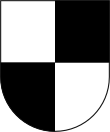
Back Huis van Hohenzollern Afrikaans Hohenzollern ALS آل هوهنتسولرن Arabic بيت هوهنتسولرن ARZ Dinastía Hohenzollern AST Hohensollernlər Azerbaijani Гогенцолерны Byelorussian Хоенцолерн Bulgarian Tiegezh Hohenzollern Breton Hoencolerni BS
| House of Hohenzollern | |
|---|---|
 | |
| Country | Germany, Romania |
| Etymology | Hohenzollern Castle |
| Founded | Before 1061 |
| Founder | Burkhard I, Lord of Zollern |
| Current head |
|
| Final ruler |
|
| Titles |
|
| Estate(s) | Germany, Prussia, Romania, Russia |
| Deposition |
|
| Cadet branches | |
The House of Hohenzollern (/ˌhoʊənˈzɒlərn/, US also /-nˈzɔːl-, -ntˈsɔːl-/;[1][2][3][4] German: Haus Hohenzollern, pronounced [ˌhaʊs hoːənˈtsɔlɐn] ⓘ; Romanian: Casa de Hohenzollern) is a formerly royal (and from 1871 to 1918, imperial) German dynasty whose members were variously princes, electors, kings and emperors of Hohenzollern, Brandenburg, Prussia, the German Empire, and Romania. The family came from the area around the town of Hechingen in Swabia during the late 11th century and took their name from Hohenzollern Castle.[5] The first ancestors of the Hohenzollerns were mentioned in 1061.
The Hohenzollern family split into two branches, the Catholic Swabian branch and the Protestant Franconian branch,[6] which ruled the Burgraviate of Nuremberg and later became the Brandenburg-Prussian branch. The Swabian branch ruled the principalities of Hohenzollern-Hechingen and Hohenzollern-Sigmaringen until 1849, and also ruled Romania from 1866 to 1947. Members of the Franconian branch became Margrave of Brandenburg in 1415 and Duke of Prussia in 1525.
The Margraviate of Brandenburg and the Duchy of Prussia were ruled in personal union after 1618 and were called Brandenburg-Prussia. From there, the Kingdom of Prussia was created in 1701, eventually leading to the unification of Germany and the creation of the German Empire in 1871, with the Hohenzollerns as hereditary German Emperors and Kings of Prussia.
Germany's defeat in World War I in 1918 led to the German Revolution. The Hohenzollerns were overthrown and the Weimar Republic was established, thus bringing an end to the German and Prussian monarchy. Georg Friedrich, Prince of Prussia, is the current head of the formerly royal Prussian line, while Karl Friedrich, Prince of Hohenzollern, is the head of the formerly princely Swabian line.[6]
- ^ "Hohenzollern". The American Heritage Dictionary of the English Language (5th ed.). HarperCollins. Retrieved 18 May 2019.
- ^ "Hohenzollern". Collins English Dictionary. HarperCollins. Retrieved 18 May 2019.
- ^ "Hohenzollern" (US) and "Hohenzollern". Lexico UK English Dictionary. Oxford University Press. Archived from the original on 2020-02-14.
- ^ "Hohenzollern". Merriam-Webster.com Dictionary. Retrieved 18 May 2019.
- ^ "Encyclopædia Britannica. Hohenzollern Dynasty".
- ^ a b Genealogisches Handbuch des Adels, Fürstliche Häuser XIX. "Haus Hohenzollern". C.A. Starke Verlag, 2011, pp. 30–33. ISBN 978-3-7980-0849-6.
© MMXXIII Rich X Search. We shall prevail. All rights reserved. Rich X Search